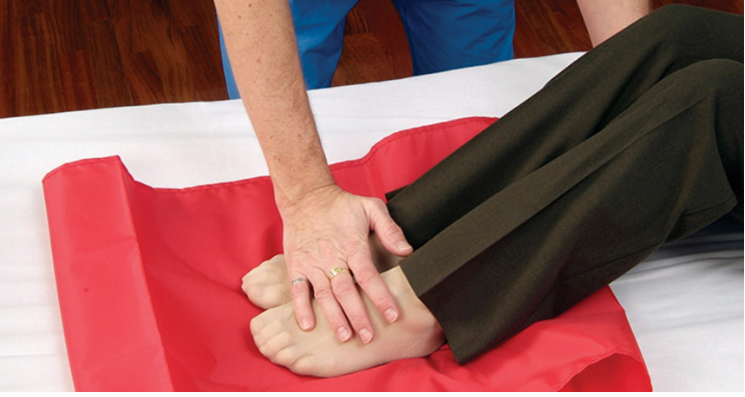It is paramount that they undertake this procedure safely, following best-practice guidelines to minimise the risk of injury or harm to themselves, colleagues or patients.
In the past, staff may have resorted to using bed sheets to move patients up the bed; this is not recommended because there is a risk of tearing or causing friction burns to patients’ skin.
Slide sheets
Slide sheets enable patients to be slid up a surface or over on to their side, that is, up the bed or rolled over in bed.
These sheets reduce the risk of shearing to patients’ skin and also reduce the amount of pushing and pulling that nurses have to do.
There are different types of slide sheets and it is important to be familiar with manufacturers’ recommendations on how they should be used.
Safe storage is essential - slide sheets are often made of slippery material and can be hazardous. These sheets should not be left on the floor or under an unattended patient but should be stowed where they can be easily retrieved but will not cause accidents.
The procedure
To undertake this particular procedure:
ü Perform a risk assessment. Assess the patient for sliding up the bed; check their mobility care plan and consult colleagues.
ü Determine how many staff will be required for the task and ascertain the equipment that will be needed.
ü Explain the procedure to the patient. Advise them that staff will slide them up the bed using a slide sheet but they may be asked to do simple actions such as placing their chin on their chest when staff help them to roll.
ü Ensure the patient’s privacy - screen the bed and ensure the patient will not be exposed, using bedlinen.
ü Ensure the environment is safe. Remove any obstructions that could hinder the manoeuvre, such as chairs or patients’ belongings. Check there is nothing slippery on the floor, such as water spillages.
ü Ensure the bed brakes are on. The bed should be at a safe working height. This is the optimal working height between the staff carrying out the manoeuvre - median height in respect of the handlers’ waist and pelvis..
ü Wash and dry hands; put on a plastic apron when rolling patients to insert a slide sheet; gloves only need to be worn if staff will be coming into contact with blood or bodily fluids.
ü Check the slide sheet, ensuring it is the correct size and clean. Ensure that the manufacturers’ instructions are followed.
ü Carer/Nurse A: assist the patient to ease slightly onto their side towards carer/nurse B, asking them to place the lower arm away from their side (or to raise it slightly above themselves on the pillow) and their upper arm on their chest . Ask the patient to look towards nurse B. Take care to ensure the patient is not exposed.
ü Carer/Nurse A: prepare the sheet - roll it in half so it can be placed under the patient .
ü Carer/Nurse A: insert the slide sheet under the patient, ensuring that their head, trunk and legs are on the slide sheet . If the patient’s feet are not on it, place a smaller slide sheet under them to prevent shearing and friction burns to heels.
ü Roll the patient onto their back and onto the slide sheet. It may be necessary to ease them slightly over on the opposite side towards nurse A to check that the slide sheet is positioned correctly. If using a circular slide sheet, the sheet openings should be on the side, with the top fold facing towards the top of the bed.
ü Both carers/nurses should adopt a safe position before sliding the patient, standing either side of the patient’s bed at the pillow end with one leg forward ready to transfer the weight backwards on to their other leg. Both nurses then grasp the upper part of the slide sheet . The lead carer/nurse should then say ‘ready, steady, slide’. Working together, both carers/nurses should gradually slide the patient up the bed. It is important not to lift with the slide sheet. It may be necessary to undertake the procedure in stages.
ü Once they are in the desired position, ease the patient over to remove the slide sheet or follow the manufacturers’ instructions on its removal. It is important not to pull the slide sheet out towards the lower end of the bed as this can cause the patient to slide back down the bed.
ü Do not leave a slide sheet under the patient unless it has been assessed as safe.
ü Ensure the patient is comfortable and not exposed before drawing back the screens.
Find the Protec® range of Slide Sheets and Transfer Boards here:
🌐 https://www.protec.uk.com/category/slide-sheets-transfer-boards
Protec® supply high quality products selected specifically for the care industry. Ranging from general consumables such as cleaning chemicals, janitorial supplies, disposable gloves, aprons and patient wipes to equipment items such as profiling beds, alternating mattresses, furniture and hoisting equipment.
We are based in heart of Cornwall and deliver nationwide.
Delivery is FREE to Trade Customers on orders over £45
Next Day Delivery also available.
See here for more details:
🌐 https://www.protec.uk.com/delivery-collections-returns-info




